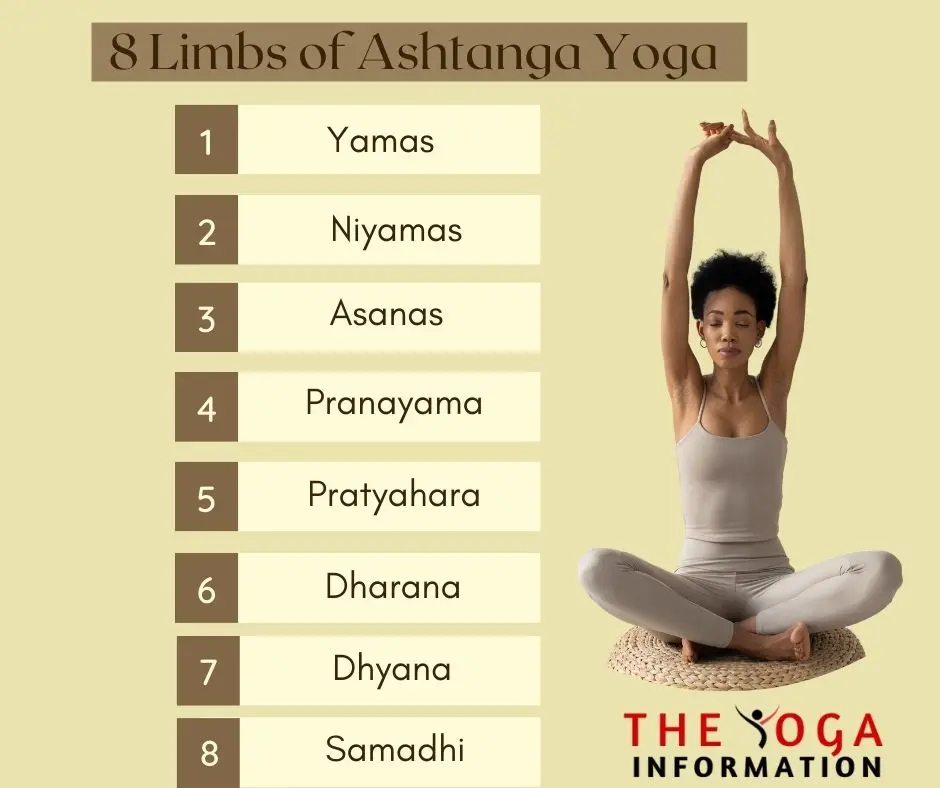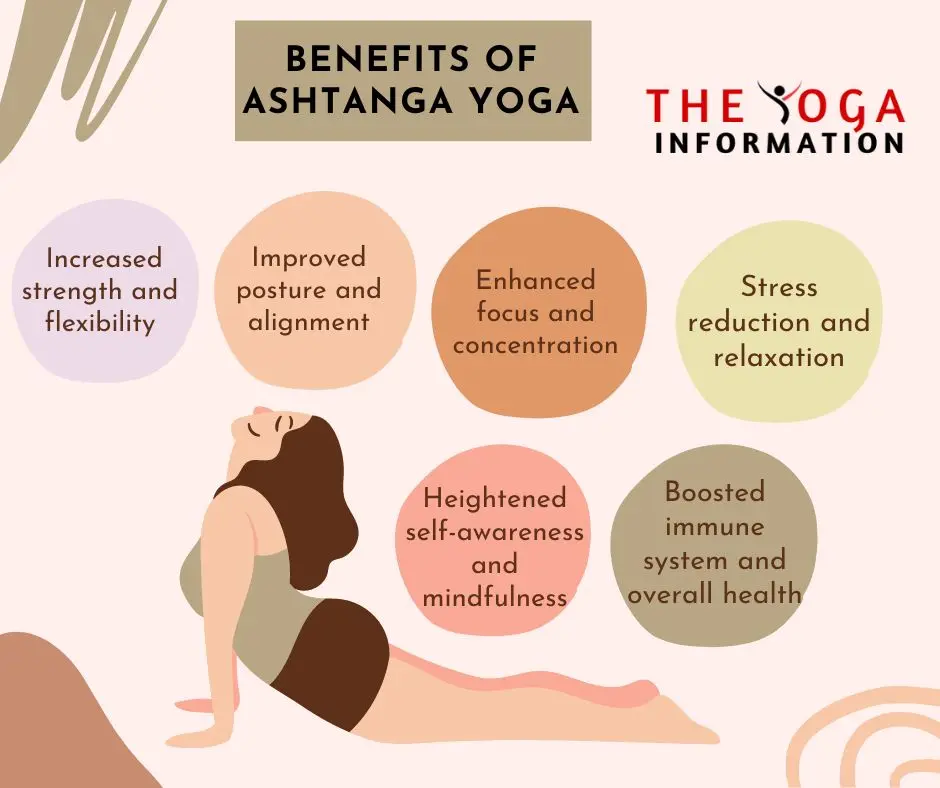What is Ashtanga Yoga
Ashtanga Yoga, also known as the Eight-Limbed Yoga, is a popular and dynamic form of yoga that emphasizes strength, flexibility, and breath control. Ashtanga Yoga involves a series of flowing and synchronized postures, each connected by a steady and deep breath. This practice focuses on building heat in the body through a vigorous and structured sequence, helping to purify the body and calm the mind. Ashtanga Yoga is a great way to improve physical fitness, increase mindfulness, and cultivate a deeper connection between the body, mind, and spirit. A Comprehensive Guide Ashtanga Yoga, also known as the eight-limbed yoga, is a powerful and transformative practice that has been revered for centuries
8 Limbs of Ashtanga Yoga

Ashtanga Yoga, also known as the “Eight Limbs of Yoga,” is a comprehensive system that encompasses various aspects of physical, mental, and spiritual well-being. Derived from the ancient text of the Yoga Sutras of Patanjali, Ashtanga Yoga provides a roadmap for achieving a harmonious and balanced life.
1. Yamas
The first limb of Ashtanga Yoga is Yamas, which refers to moral and ethical principles. Yamas guides practitioners to adopt a righteous way of living, emphasizing values such as non-violence (ahimsa), truthfulness (satya), non-stealing (asteya), moderation (brahmacharya), and non-possessiveness (aparigraha). Incorporating these principles into daily life helps individuals cultivate a sense of compassion, integrity, and respect for others.
2. Niyamas
The second limb, Niyamas, focuses on self-discipline and observances. Niyamas encourages practitioners to develop positive qualities such as self-study (svadhyaya), contentment (santosha), purity (shaucha), self-discipline (tapas), and surrender to a higher power (ishvara pranidhana). By practicing Niyamas, individuals can enhance self-awareness, cultivate gratitude, and foster self-growth.
3. Asanas
The third limb, Asanas, comprises physical postures that are commonly associated with yoga. Asanas involve a series of poses that promote strength, flexibility, and balance. Through regular practice, individuals improve their physical fitness, release tension, and enhance body awareness. Ashtanga Yoga emphasizes a specific sequence of asanas, known as the Primary Series, which systematically targets different areas of the body.
4. Pranayama
The fourth limb, Pranayama, focuses on breath control. Pranayama techniques involve conscious regulation of the breath, which helps to direct and enhance the flow of prana (life force energy) within the body. By practicing Pranayama, individuals can experience improved respiratory function, increased vitality, and a calm state of mind.
5. Pratyahara
The fifth limb, Pratyahara, involves the withdrawal of the senses from external distractions. Through Pratyahara, practitioners learn to detach from sensory stimuli and turn their attention inward. This practice allows individuals to cultivate a deeper sense of self-awareness, focus, and concentration.
6. Dharana
The sixth limb, Dharana, refers to concentration. Dharana involves directing one’s attention to a single point of focus, such as a mantra, an object, or the breath. By practicing Dharana, individuals develop mental clarity, enhance memory, and cultivate a state of deep concentration.
7. Dhyana
The seventh limb, Dhyana, signifies meditation. Dhyana involves the continuous flow of awareness in a state of undisturbed focus. Through regular meditation practice, individuals can experience a sense of inner calm, heightened intuition, and a deeper connection to their inner selves.
8. Samadhi
The final limb, Samadhi, represents a state of blissful union. Samadhi is the ultimate goal of Ashtanga Yoga, where the practitioner transcends the ego and experiences a profound sense of oneness with the universe. In this state, one attains a state of pure consciousness, inner peace, and profound spiritual realization.
Benefits of Ashtanga Yoga

1. Increased strength and flexibility
Ashtanga Yoga is a physically demanding practice that focuses on building strength and flexibility. Through a series of dynamic postures and sequences, practitioners engage and tone their muscles, promoting overall physical fitness. With regular practice, you will notice improved muscle tone, increased flexibility, and enhanced body awareness.
2. Improved posture and alignment
Ashtanga Yoga places a strong emphasis on proper alignment, helping to correct and improve posture. The practice works to strengthen the core muscles, which are essential for maintaining good posture. By aligning the body correctly, you can prevent injuries, reduce chronic pain, and cultivate a more confident and upright posture.
3. Enhanced focus and concentration
Ashtanga Yoga is a moving meditation that demands your full attention and focus. The synchronized breath and movement help to quiet the mind and bring you into the present moment. With regular practice, you will notice an improvement in your ability to concentrate and stay focused, both on and off the mat.
4. Stress reduction and relaxation
Ashtanga Yoga offers a much-needed respite from the fast-paced and stressful nature of modern life. The practice incorporates deep breathing and relaxation techniques, which activate the body’s relaxation response and promote a sense of calm. Regular practice can help reduce stress, anxiety, and promote better sleep patterns.
5. Heightened self-awareness and mindfulness
Ashtanga Yoga encourages practitioners to cultivate self-awareness and mindfulness. By observing the breath, body sensations, and thoughts, you learn to become more present and in tune with yourself. This increased self-awareness can lead to a deeper understanding of your thoughts, emotions, and patterns, empowering you to make positive changes in your life.
6. Boosted immune system and overall health
Ashtanga Yoga stimulates the organs, glands, and nervous system, promoting better overall health. The practice helps to improve circulation, detoxify the body, and boost the immune system. Through regular practice, you may experience fewer illnesses, improved digestion, and increased vitality.
Steps to practice Ashtanga Yoga
Practicing Ashtanga Yoga can be a transformative experience for both the body and mind. By following these steps and incorporating the traditional sequence of postures, you can develop strength, flexibility, and inner peace through this powerful practice
1. Opening Chant
To begin your Ashtanga Yoga practice, it is traditional to start with an opening chant, also known as the invocation. This is a Sanskrit chant that pays homage to the lineage of yoga and serves as a way to set the intention for your practice.
2. Sun Salutations (Surya Namaskara A and B)
The next step in the Ashtanga Yoga practice is the Sun Salutations. These are a series of dynamic movements that warm up the body and prepare it for the more intense poses to come. There are two variations of Sun Salutations in Ashtanga Yoga, Surya Namaskara A and B, which are repeated multiple times.
3. Standing Poses
After completing the Sun Salutations, you will move on to a series of standing poses. These poses help to improve strength, flexibility, and balance. Some examples of standing poses in Ashtanga Yoga include Trikonasana (Triangle Pose), Virabhadrasana (Warrior Pose), and Utthita Parsvakonasana (Extended Side Angle Pose).
4. Seated Poses
Once you have completed the standing poses, you will transition into a series of seated poses. These poses focus on opening up the hips, lengthening the spine, and cultivating a sense of grounding. Some common seated poses in Ashtanga Yoga include Janu Sirsasana (Head-to-Knee Pose), Paschimottanasana (Seated Forward Bend), and Ardha Matsyendrasana (Half Lord of the Fishes Pose).
5. Finishing Sequence
After the seated poses, you will move on to the finishing sequence. This part of the practice includes inversions, backbends, and poses that help to cool down the body and bring it into a state of relaxation. Some examples of finishing poses in Ashtanga Yoga include Sarvangasana (Shoulderstand), Halasana (Plow Pose), and Setu Bandhasana (Bridge Pose).
6. Closing Sequence and Closing Chant
To complete your Ashtanga Yoga practice, you will finish with a closing sequence and a closing chant. The closing sequence involves gentle stretches and relaxation poses to help the body cool down and prepare for final relaxation. The closing chant is a way to express gratitude for the practice and bring it to a close.
Harmful effects of Ashtanga Yoga

Ashtanga Yoga is a popular form of yoga that focuses on a dynamic and intense physical practice. While it offers numerous benefits for the body and mind, it is important to be aware of the potential harmful effects that can arise from practicing Ashtanga Yoga.
1. Physical injuries
Ashtanga Yoga involves a series of challenging and advanced poses, which can put a strain on the body if not practiced with proper alignment and caution. Without proper guidance and preparation, practitioners may be at risk of experiencing physical injuries such as muscle strains, sprains, or even more serious injuries like torn ligaments or fractures.
2. Overexertion
Ashtanga Yoga is known for its intense and demanding sequences, which require practitioners to move through a series of poses quickly and continuously. This can lead to overexertion, especially for beginners or individuals who are not adequately conditioned. Overexertion can result in fatigue, muscle soreness, and even burnout, which may discourage individuals from continuing their yoga practice altogether.
3. Emotional and mental stress
Ashtanga Yoga can be physically demanding, but it can also take a toll on one’s emotional and mental well-being. The pressure to perform and progress in the practice, combined with the intense physical exertion, can lead to emotional and mental stress. This can manifest as feelings of inadequacy, frustration, or even anxiety, which can have a negative impact on one’s overall mental health.
4. Detachment from other aspects of life
Ashtanga Yoga often requires a significant time commitment, as practitioners are encouraged to practice daily or multiple times a week. This level of dedication can lead to a detachment from other important aspects of life, such as work, relationships, and hobbies. While a dedicated yoga practice can be beneficial, it is essential to find a balance that allows for the fulfillment of other responsibilities and interests.
5. Unsustainable practice
The rigorous nature of Ashtanga Yoga can make it difficult to maintain a long-term practice. Due to its intensity, some individuals may find it challenging to sustain the physical demands of the practice as they age or if they have pre-existing injuries or health conditions. It is important to listen to your body and make modifications or seek alternatives if necessary to ensure a sustainable and enjoyable yoga journey.






